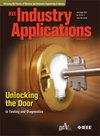基于时间步进有限元模型的双励磁同步发电机暂态和次暂态参数数值计算
IF 4.5
2区 工程技术
Q2 ENGINEERING, ELECTRICAL & ELECTRONIC
引用次数: 0
摘要
双励磁同步发电机(DESG)转子上有两组励磁绕组,因此比传统的同步发电机具有更好的稳定性和可靠性。然而,由于两种发电机转子结构的不同,DESG的暂态参数与传统同步发电机不同。本文建立了300mw DESG端区三维电磁场模型,计算并比较了不同工况下DESG端区的磁密度和能量密度。采用能量法计算定子和转子端漏抗。在不同工况下,q轴磁场绕组的端漏抗变化幅度为11%,与d轴磁场绕组和定子绕组相比,q轴磁场绕组的端漏抗变化最大。在此基础上,将末端漏抗代入二维场路耦合时步有限元模型(FCCTSFEM),用于计算DESG的频率特性。采用FCCTSFEM和频域法相结合的方法,计算了该结构的瞬态和亚瞬态参数。研究了楔形槽材料对瞬态和亚瞬态参数的影响。随着转子槽楔电导率的增大,瞬态和亚瞬态电抗减小,瞬态和亚瞬态时间常数增大。研究结果可为DESG的参数计算提供理论依据。本文章由计算机程序翻译,如有差异,请以英文原文为准。
Numerical Calculation for Transient and Sub-Transient Parameters of Dual-Excited Synchronous Generator Based on Time-Stepping Finite Element Model
The Dual-Excited Synchronous Generator (DESG) has two sets of field windings on the rotor, thus it has better stability and reliability than the traditional synchronous generator. However, the transient parameters of the DESG are different from those of the traditional synchronous generator due to the different rotor structure of the two generators. In this paper, a three-dimensional electromagnetic field model in the end region of a 300-MW DESG is established and the magnetic density and energy density in the end region of DESG are calculated and compared under the different operating conditions. The stator and rotor end leakage reactances are calculated by the energy method. Under the different operating conditions, the end leakage reactance of q-axis field winding varies by 11%, which is the largest compared to those of the d-axis field winding and stator winding. Based on that, the end leakage reactances are substituted into the two-dimensional field-circuit coupled time-stepping finite element model (FCCTSFEM), which is used to calculate the frequency characteristic of the DESG. The transient and sub-transient parameters of the DESG are calculated by combining the FCCTSFEM and the frequency domain method. The influence of the slot wedge material on the transient and sub-transient parameters are studied. Along with the increase of the rotor slot wedge conductivity, the transient and sub-transient reactances are reduced and the transient and sub-transient time constants are increased. The results can provide a theoretical basis for the parameter calculation of the DESG.
求助全文
通过发布文献求助,成功后即可免费获取论文全文。
去求助
来源期刊

IEEE Transactions on Industry Applications
工程技术-工程:电子与电气
CiteScore
9.90
自引率
9.10%
发文量
747
审稿时长
3.3 months
期刊介绍:
The scope of the IEEE Transactions on Industry Applications includes all scope items of the IEEE Industry Applications Society, that is, the advancement of the theory and practice of electrical and electronic engineering in the development, design, manufacture, and application of electrical systems, apparatus, devices, and controls to the processes and equipment of industry and commerce; the promotion of safe, reliable, and economic installations; industry leadership in energy conservation and environmental, health, and safety issues; the creation of voluntary engineering standards and recommended practices; and the professional development of its membership.
 求助内容:
求助内容: 应助结果提醒方式:
应助结果提醒方式:


